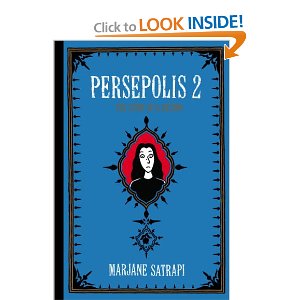 First line: November 1984. I am in Austria.
First line: November 1984. I am in Austria.
From the inside cover: In Persepolis, heralded by the Los Angeles Times as “one of the freshest and most original memoirs of our day,” Marjane Satrapi dazzled us with her heartrending memoir-in-comic-strips about growing up in Iran during the Islamic Revolution. Here is the continuation of her fascinating story.
In 1984, Marjane flees fundamentalism and the war with Iraq to begin a new life in Vienna. Once there, she faces the trials of adolescence far from her friends and family, and while she soon carves out a place for herself among a group of fellow outsiders, she continues to struggle for a sense of belonging.
Finding that she misses her home more than she can stand, Marjane returns to Iran after graduation. Her difficult homecoming forces her to confront the changes both she and her country have undergone in her absence and her shame at what she perceives as her failure in Austria. Marjane allows her past to weigh heavily on her until she finds some like-minded friends, falls in love, and begins studying art at a university. However, the repression and state-sanctioned chauvinism eventually lead her to question whether she can have a future in Iran.
As funny and poignant as its predecessor, Persepolis 2 is another clear-eyed and searing condemnation of the human cost of fundamentalism. In its depiction of the struggles of growing up – here compounded by Marjane’s status as an outsider both abroad and at home – it is raw, honest, and incredibly illuminating.
My thoughts: I read this because I had recently read Reading Lolita in Tehran and Persepolis 1 for my book club. I had heard that there was another Persepolis story and since I really enjoyed the first one, thought I would like the second one. I have to say that I didn’t enjoy it as much.The story picks up where Persepolis 1 ended – Marjane is sent by her parents to study in Vienna, Austria to escape the bombings and uncertainty of the Iran-Iraq war. I felt this story was not as compelling as the first. As a child, you are able to love Marjane for her childishness and also see clearly everything from the hypocrisies of her self-proclaimed non-traditional parents to how she and her classmates treat other children. Now that she’s a young adult, it’s difficult to not see how her stubbornness makes her cut off her own nose – she winds up homeless after a series of pride issues. Young Marjane was feisty and independent and it’s cute. Older Marjane is stubborn and prideful and more difficult to accept. I did find the graphics to once again be powerful and know that both these stories will stay with me for a while. As with the first story, I am left wanting to know more about the Iranian culture, specifically the injustices done to women.
(I borrowed this book from the library.)